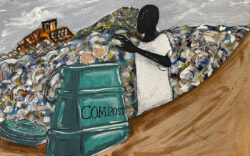Boasting 10,000 acres of undeveloped wilderness and seven miles of pristine beaches, Little St. Simons Island has survived as a paradisal environment safeguarded from the exploitative and damaging consequences of land development and tourism. Privately owned for over a century and accessible only by boat, it’s one of the least developed of Georgia’s Golden Isles. While it is possible to visit the island—a lodge accommodates no more than 32 overnight guests per day—nature lovers can just as easily tour its remarkably diverse grounds through The Wild Treasury of Nature: A Portrait of Little St. Simons Island by Philip Juras.
Published this month by the University of Georgia Press, the hardback book contains a collection of landscape oil paintings by the Athens-based artist. Attentive to the delicate lighting, dancing shadows and naturally occurring patterns surrounding him, Juras effectively captures both the raw beauty and underlying coastal processes of the small island with near-photographic precision.
A native of Augusta, Juras received both a BFA in drawing and painting and a masters degree in landscape architecture from UGA. His lifelong admiration for the natural world led him to producing The Southern Frontier: Landscapes Inspired by Bartram’s Travels in 2011, a collection of more than 60 oil paintings inspired by the written descriptions of late-18th Century naturalist William Bartram. Co-sponsored by the Georgia Sea Grant, published by the Telfair Museum in Savannah and distributed by UGA Press, the accompanying exhibit book offers a glimpse into what the pre-settlement Southern wilderness might have looked like.
An invitation to visit and paint Little St. Simons was offered to Juras after environmental educator and conservation advocate Wendy Paulson, who owns the island with her husband Hank, serendipitously viewed—and was smitten with—the artist’s exhibition of Bartram-inspired paintings at the Telfair Museum. Over the course of the following three and a half years, Juras made many visits to the island, documenting its forest, marshes and beaches throughout the changing seasons. As his body of work grew, the artist conceived the idea of turning the collection into a traveling exhibition and accompanying publication. Currently on view at the Morris Museum of Art in Augusta through May, the original paintings will venture over to the Cobb/Marietta Museum of Art in July.
In the book’s introduction, Morris Director Kevin Grogan writes, “Viewers recognized that there was something more to the Telfair’s exhibition than was immediately revealed by Juras’ technically skilled, beautifully crafted, highly detailed paintings. Once one gets past the obvious romantic appearance of the paintings and their apparent record of man’s part in the Divine Plan, a more detached assessment of his work leads to the conclusion that Juras’ considerable skills serve a larger purpose: It is as much a critical examination of natural and cultural history as it is an attempt to chronicle a vanishing wilderness.”
Rather than attempting to portray Little St. Simons’ vastness and diversity on a single canvas, Juras takes a cataloguing approach by focusing on different ecological aspects within each frame. A full portrait of the island is collectively created when the images are assembled and viewed together. The Wild Treasury of Nature is presented in an order both artistically and ecologically informed, intentionally working its way from the heart of the maritime live oak forest, through the marshes and out to the shoreline. The landscapes gradually become more open as the terrain evolves from dense, intricately tangled greenery to rolling dunes, calm waters and sun-kissed horizons.
The collection totals 52 scenes selected from approximately 40 small field works and 20 large studio paintings completed between April 2011 and February 2015. Many of the studio paintings began with reviewing photographs shot from several angles, a process which allowed him to capture light effects too fleeting to sketch out on-site. The plein-air oil sketches, on the other hand, largely served as memory guides and were essential in preserving observations from within deep, heavily vegetated forest thickets where darkly lit photographs would not have sufficed.
Though intentionally stepping around any clear evidence of humans and their remnants—narrow dirt roads, historic dike systems and the visitors’ lodge—a few influences of mankind still permeate the scenes, such as a location where thousands of oyster shells were discarded long ago. Still, the paintings embody a very rare and precious place that has remained virtually untouched for centuries.
Janice Simon, the Josiah Meigs distinguished teaching associate professor of art history at the Lamar Dodd School of Art, compares Juras to 19th Century American landscape painters such as Frederic Edwin Church, Albert Bierstadt and John Frederick Kensett in her included essay “This Forest in the Sea.”
“Nineteenth Century painters evoked the sublime in nature by creating seemingly limitless expanses beyond the horizon, engulfing claustrophobic compositions, contrasting extremes of brightness and darkness, broken surfaces and sharp edges, situations of chaotic crowding and disarming solitude,” she writes.
Like many of the landscapists before him, Juras pursues the sublime while combatting harsh elements—good ol’ Southern humidity, swarms of bloodthirsty mosquitoes and chaotic forest fires—to record nature’s unique spaces and illuminate their environmental value.
The Wild Treasury of Nature also features “An Island at the Edge of Time,” a very informative essay on the island’s ecological and cultural histories by Dorinda G. Dallmeyer, director of the Environmental Ethics Certificate Program at UGA. Avid Bookshop will host a book launch for The Wild Treasury of Nature with Juras, Simon and Dallmeyer on Thursday, Mar. 31 from 6:30–7:30 p.m.
Like what you just read? Support Flagpole by making a donation today. Every dollar you give helps fund our ongoing mission to provide Athens with quality, independent journalism.










